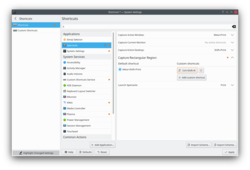Graphics: V3D and Wayland
-
November Update: Exploring V3D - Maíra Canal
Currently, V3D only has three basic IGT tests: v3d_get_bo_offset, v3d_get_param, and v3d_mmap. So, the basic goal of my CE project was to add more tests to the V3D driver.
As the general DRM-core tests were in a good shape on the V3D driver, I started to think together with my mentors about more driver-specific tests for the driver.
By checking the V3D UAPI, you can see that the V3D has eleven ioctls, so there is yet a lot to test for the V3D on IGT.
First, there are Buffer Object (BO) related-ioctls: v3d_create_bo, v3d_wait_bo, v3d_mmap_bo, and v3d_get_bo_offset. The Buffer Objects are shared-memory objects that are allocated by the GPU to store things like vertex data. Therefore, testing them is important to make sure that memory is being correctly allocated. Different from the VC4, the V3D has an MMU between the GPU and the bus, allowing it to not allocate objects contiguously. Therefore, the idea was to develop tests for v3d_create_bo and v3d_wait_bo.
Next, there are Performance Monitor (perfmon) related-ioctls: v3d_perfmon_create, v3d_perfmon_destroy, and v3d_perfmon_get_values. Performance Monitors are basically registers that are used for monitoring the performance of the V3D engine. So, tests were designed to assure that the driver was creating perfmons properly and was resilient to incorrect requests, such as trying to get a value from a non-existent perfmon.
-
Wayland native interface in Qt 6.5
Qt 6 introduced a new way to access platform specific objects and functionality in the QNativeInterface namespace. Starting with Qt 6.5 it will be possible to obtain handles to wayland object handles this way. Let’s look at what’s new and how it improves on the past method.
In Qt 5 there were to two options to access platform-specific API and native handles of the current platform. If you were lucky, your platform had an ‘Extras’ module like Qt Max Extras, Qt X11 Extras or Qt Android Extras. However these were removed for Qt 6 and if you ever needed something that was not exposed this way or the platform had no ‘Extras’ module (like Wayland), it was also possible to access functionality via QPlatformNativeInterface. An example usage of would look like this:
-
Shirish Agarwal: Wayland, Hearing aids, Multiverse & Identity
First up, I read Antoine Beaupré’s Wayland to Sway migration with interest. While he said it’s done and dusted or something similar, the post shows there’s still quite a ways to go. I wouldn’t say it’s done or whatever till it’s integrated so well that a person installs it and doesn’t really need to fiddle with config files as an average user. For specific use-cases you may need to, but that should be outside of a normal user (layperson) experience.
I have been using mate for a long long time and truth be told been very happy with it. The only thing I found about Wayland on mate is this discussion or rather this entry. The roadmap on Ubuntu Mate is also quite iffy. The Mate Wayland entry on Debian wiki also perhaps need an updation but dunno much as the latest update it shares is 2019 and it’s 2022. One thing to note, at least according to Antoine, things should be better as and when it gets integrated even on legacy hardware. I would be interested to know how it would work on old desktops and laptops rather than new or is there some barrier? I, for one would have liked to see or know about why lightdm didn’t work on Wayland and if there’s support. From what little I know lightdm is much lighter than gdm3 and doesn’t require much memory and from what little I have experienced works very well with mate. I have been using it since 2015/16 although the Debian changelog tells me that it has been present since 2011. I was hoping to see if there was a Wayland specific mailing list, something like debian-wayland but apparently there’s not :(. Using ‘mate desktop wayland’ (tried few other variations on the keywords) but search fails to find any meaningful answer :(. FWIW and I don’t know the reason why but Archwiki never fails to amaze me. Interestingly, it just says No for mate. I probably would contact upstream in the coming days to know what their plans are and hopefully they will document what their plans are on integrating Wayland in both short-term and long-term with an update, or if there is something more recent they have documented elsewhere, get that update on the Debian wiki so people know.
The other interesting thread I read was Russel Coker’s Thinkpad X1 Carbon Gen5 entry. I would be in the market in a few months to find/buy a Thinkpad but probably of AMD rather than Intel because part of recent past history with Intel as well as AMD having a bit of an edge over Intel as far as graphics is concerned. I wonder why Russel was looking into Intel and not AMD. Would be interested to know why Intel and not AMD? Any specific reason ???

